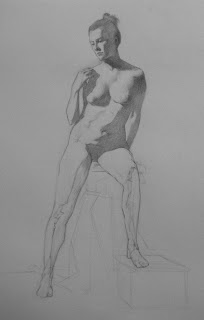
Bones and muscles, anterior view
Graphite and colored pencil on vellum, 8.5 x 11 inches
Ecorche/Anatomy class with Andrew Ameral
Ecorche drawing homework: Andy gave us a photo of a living model, front and back views, and we had to draw an overlay of the skeleton, and then another overlay of the muscles we have studied so far. Oh, and label them.

Bones and muscles, anterior view
Graphite and colored pencil on vellum, 8.5 x 11 inches
Ecorche/Anatomy class with Andrew Ameral
I did the drawings copying from Richer's anatomy book and handouts Andy has designed for the class.
Below is the current state of Sid. The class has been going nearly every Saturday for 5 months now, and tragically I am going to miss the last three classes due to a previously scheduled vacation. I'll get more muscles done on the upper legs in class next week, but that's it. Luckily Andy has given me the opportunity to finish up later.
I have learned so much from this class and I'm so glad I got the opportunity to take it!
Below is the current state of Sid. The class has been going nearly every Saturday for 5 months now, and tragically I am going to miss the last three classes due to a previously scheduled vacation. I'll get more muscles done on the upper legs in class next week, but that's it. Luckily Andy has given me the opportunity to finish up later.
















































